
Installation Manual
25500445
Rev. A1 0923
Printed in U.S.A.
© Copyright 2018-2023 Federal Signal Corporation
Yagi and Omni Antennas

Limited Warranty
This product is subject to and covered by a limited warranty,
a copy of which can be found at www.fedsig.com/SSG-Warranty.
A copy of this limited warranty can also be obtained by written
request to Federal Signal Corporation, 2645 Federal Signal Drive,
University Park, IL 60484, email to [email protected] or
call +1 708-534-3400.
This limited warranty is in lieu of all other warranties, express or
implied, contractual or statutory, including, but not limited to the
warranty of merchantability, warranty of tness for a particular
purpose and any warranty against failure of its essential purpose.
2645 Federal Signal Drive
University Park, Illinois 60484
www.fedsig.com
Customer Support 800-548-7229 • +1 708 534-3400
Technical Support 800-524-3021 • +1 708 534-3400
All product names or trademarks are properties of their respective owners.

3
Installation Manual
Federal Signal www.fedsig.com
Contents
Safety Messages......................................................................................................................................................4
General Description ................................................................................................................................................6
Introduction .........................................................................................................................................................6
Ordering Information ...........................................................................................................................................6
Planning your Antenna System ........................................................................................................................... 7
Installing the Antennas ...........................................................................................................................................7
Installing the Yagi Antenna .................................................................................................................................8
Yagi Antenna Pre-Assembly Instruction ...................................................................................................... 8
Final VSWR Tuning .............................................................................................................................................9
Mounting the Yagi Antenna ..............................................................................................................................10
Installing the Omni and Omni-B Series Antennas ............................................................................................. 11
Getting Service ......................................................................................................................................................14
Figures
Figure 1 Yagi Antenna Installation Example .......................................................................................................10
Figure 2 Omni Antenna Installation Example ..................................................................................................... 11
Figure 3 Omni-B Series Antenna Installation Example ......................................................................................12
Figure 4 Antenna Grounding ................................................................................................................................ 13
Figure 5 Typical Antenna Pole Mount (AMP-P) Installation ............................................................................... 15
Figure 6 Typical Antenna Wall Mount (AMP-W) Installation ..............................................................................16
Figure 7 Typical Omni-B Series Antenna Pole Mount (AMB-P) Installation ..................................................... 17
Figure 8 Typical Omni-B Series Antenna Pole Mount (AMB-P) Installation ..................................................... 18
Tables
Table 1 Ordering Omni Antennas ........................................................................................................................... 6
Table 2 Ordering Omni-B Series Antennas ...........................................................................................................6
Table 3 Determining Maximum Reected Power ..................................................................................................6
Table 4 Ordering Yagi Antennas .............................................................................................................................7

4
Safety Messages
Yagi and Omni Antennas
Federal Signal www.fedsig.com
Safety Messages
It is important to follow all instructions shipped with this product. This device is to be
installed by trained personnel who are thoroughly familiar with the country’s electric
codes and will follow these guidelines as well as local codes and ordinances, including
any state or local noise-control ordinances.
Listed below are important safety instructions and precautions you should follow:
Important Notice
Federal Signal reserves the right to make changes to devices and specifications detailed
in the manual at any time to improve reliability, function, or design. The information in
this manual has been carefully checked and is believed to be accurate; however, no
responsibility is assumed for any inaccuracies.
Publications
Federal Signal recommends the following publications from the Federal Emergency
Management Agency for assistance with planning an outdoor warning system:
• The “Outdoor Warning Guide” (CPG 1-17)
• “Civil Preparedness, Principles of Warning” (CPG 1-14)
• FEMA-REP-1, Appendix 3 (Nuclear Plant Guideline)
• FEMA-REP-10 (Nuclear Plant Guideline).
Planning
• If suitable warning equipment is not selected, the installation site for the siren is
not selected properly, or the siren is not installed properly, it may not produce the
intended optimum audible warning. Follow Federal Emergency Management Agency
(FEMA) recommendations.
• If sirens are not activated in a timely manner when an emergency condition
exists, they cannot provide the intended audible warning. It is imperative that
knowledgeable people, who are provided with the necessary information, be
available at all times to authorize activation.
• When sirens are used outdoors, people indoors may not be able to hear the warning
signals. Separate warning devices or procedures may be needed to eectively warn
people indoors.
• The sound output of sirens is capable of causing permanent hearing damage. To
prevent excessive exposure, carefully plan siren placement, post warnings, and
restrict access to areas near sirens. Review and comply with any local or state noise
control ordinances as well as OSHA noise exposure regulations and guidelines.
• Activating the sirens may not result in people taking the desired actions if those to
be warned are not properly trained about the meaning of siren sounds. Users should
follow FEMA recommendations and instruct those to be warned of corrective actions
to be taken.
• After installation, service, or maintenance, test the siren system to confirm it is
operating properly. Test the system regularly to confirm it will be operational in an
emergency.

5
Safety Messages
Installation Manual
Federal Signal www.fedsig.com
• If future service and operating personnel do not have these instructions to refer
to, the siren system may not provide the intended audible warning, and service
personnel may be exposed to hazards that could result in death, permanent hearing
loss, or other bodily injuries. File these instructions in a safe place and refer to them
periodically. Give a copy of these instructions to recruits and trainees. Also give a
copy to anyone who is going to service or repair the siren.
Installation and Service
• Electrocution or severe personal injury can occur when performing various
installation and service functions such as making electrical connections, drilling
holes, or lifting equipment. Therefore, only experienced electricians should install this
product per national, state, and any other electrical codes having jurisdiction. Perform
all work under the direction of the installation or service crew safety foreman.
• The sound output of sirens is capable of causing permanent hearing damage. To
prevent excessive exposure, carefully plan siren placement, post warnings, and
restrict access to areas near the sirens. Sirens may be operated from remote control
points. Whenever possible, disconnect all siren power, including batteries, before
working near the siren.
• After installation, service, or maintenance, test the siren system to confirm it is
operating properly. Test the system regularly to confirm that it will be operational in
an emergency.
• If future service and operating personnel do not have these warnings and all other
instructions shipped with the equipment to refer to, the siren system may not provide
the intended audible warning, and service personnel may be exposed to hazards
that could result in death, permanent hearing loss, or other bodily injuries. File these
instructions in a safe place and refer to them periodically. Give a copy of these
instructions to recruits and trainees. Also give a copy to anyone who is going to
service or repair the sirens.
Operation
Failure to understand the capabilities and limitations of your siren system could result
in permanent hearing loss, other serious injuries, or death to persons too close to
the sirens when you activate them or to those you need to warn. Carefully read and
thoroughly understand all safety notices in this manual and all operations-related items in
all instruction manuals shipped with the equipment. Thoroughly discuss all contingency
plans with those responsible for warning people in your community, company, or
jurisdiction.
Read and understand the information contained in this manual before attempting
to install or service the siren.
Pay careful attention to the notice located on the equipment.

6
General Description
Yagi and Omni Antennas
Federal Signal www.fedsig.com
General Description
Introduction
This publication covers the installation of the Yagi and Omni Fiberglass Antennas.
Ordering Information
Table 1 Ordering Omni Antennas
Part Number Frequency
OMNI-0 138-140 MHz
OMNI-1 140-144 MHz
OMNI-2 144-148 MHz
OMNI-3 148-152 MHz
OMNI-4 152-156 MHz
OMNI-5 156-162 MHz
OMNI-6 162-168 MHz
OMNI-7 168-174 MHz
OMNI-15 450-460 MHz
OMNI-16 460-470 MHz
Table 2 Ordering Omni-B Series Antennas
Part Number Description Frequency
OMNI-BVL-xx VHF Low, Omni-Directional Antenna > 138-150 MHz
OMNI-BVH-xx VHF High, Omni-Directional Antenna > 150-168 MHz
OMNI-BVH-xx VHF High, Omni-Directional Antenna > 168-174 MHz
OMNI-BUL-xx UHF Low, Omni-Directional Antenna > 380-420 MHz
OMNI-BUH-xx UHF High, Omni-Directional Antenna > 420-470 MHz
OMNI-BUH-xx UHF High, Omni-Directional Antenna > 806-824 MHz
OMNI-BUH-xx UHF High, Omni-Directional Antenna > 851-869 MHz
Where xx stands for the following:
• NC = No RF cable
• 10 = 10-foot RF cable
• 35 = 35-foot cable
Table 3 Determining Maximum Reected Power
Part Number Frequency Max. Reected Power*
OMNI-BVL-xx > 138-150 MHz 15%
OMNI-BVH-xx > 150-168 MHz 15%
OMNI-BVH-xx > 168-174 MHz 20%
OMNI-BUL-xx > 380-420 MHz 20%
OMNI-BUH-xx > 420-470 MHz 16%
OMNI-BUH-xx > 806-824 MHz 11%
OMNI-BUH-xx > 851-869 MHz 5%
OMNI-0 through OMNI-16 10%
*Including 35-foot cable

7
Installing the Antennas
Installation Manual
Federal Signal www.fedsig.com
Table 4 Ordering Yagi Antennas
Part Number Frequency
YAGI-1 136-150 MHz
YAGI-2 150-174 MHz
YAGI-10 450-470 MHz
Planning your Antenna System
Proper planning of your antenna system is significantly important. VHF and UHF are
essentially line-of-site frequencies; therefore, radio transmission through a mountain or
the earth in a valley is impossible. Get the antenna as high as possible. Increasing height
by ten feet can make a significant dierence and may add miles to the coverage. LMR400
antenna cable length can be up to 200 feet for VHF and 100 feet for UHF. If a longer
antenna cable length is necessary, a higher quality cable is required.
Verify that the antenna height, frequency, location, and the radio system’s ERP (Eective
Radiated Power) are within the site’s FCC license limits. Subtract VSWR loss and cable/
connector insertion losses. To determine ERP, add the antenna’s gain to the radio power
and subtract VSWR loss and cable/connector insertion losses.
Consider the following guidelines:
• Do not have the antenna radiating element touching anything. If too close to an
object, excessive reflected power can occur.
• Place the antennas at least 1.5 feet or more from other objects.
• Separate multiple antennas vertically, not horizontally.
• Antenna cable entering a building requires grounded lightning protection at the
building entry.
Installing the Antennas
INSTALLATION PRECAUTIONS: Radio and antenna installation must conform
to the system’s FCC (or equivalent) license, which species the RF frequency,
modulation, RF power, antenna location, and mounting height. Do not operate the
radio system until the installation has been conrmed to comply with the license.
Follow these guidelines:
• Install the antenna above the roofline
• Create the service loop diameter at an 8-inch minimum radius
• Attach a gas discharge suppressor (to interrupt the antenna cable) to the ground plate
mounted to the outside of the building. This properly grounds the antenna shield and
prevents lighting from entering the building.

8
Installing the Antennas
Yagi and Omni Antennas
Federal Signal www.fedsig.com
Installing the Yagi Antenna
Yagi Antenna Pre-Assembly Instruction
To pre-assemble the antenna:
1. Unpack the antenna and locate the following parts:
• Boom (1-14 inches for 5-element model, 7/8 inch-diameter for 3-element model)
• 3/8 diameter elements (y---3 = 3 elements, y----5 = 5 elements)
• Gamma match parts bag
• Mounting bracket parts bag
2. Find the proper element dimension chart for your antenna within the antenna
instructions, and trim each element according to your operating frequency. Use care
to trim equal lengths from each end of each element to ensure that the mounting
hole is at the center.
NOTE A: Proper trimming and adjustment are critical to the Voltage Standing Wave
Ratio, known as VSWR. (High reflected power levels decrease forward power. The
life of the radio and transmit capabilities are dependent upon the VSWR being low as
possible.)
NOTE B: If two frequencies are being used, then trim the antenna to the transmit
frequency of the system where the antenna is mounted.
3. Insert the elements into their respective locations through the boom, starting with R1
(the reflective element) in the hole closest to the mounting holes. Then insert Dr, D1,
etc., in that order.
NOTE A: The shortest element is furthest away from the mount and increases in size
as it gets closer to the mount.
NOTE B: Be very careful to line up the holes and not cross thread when securing
the elements in the next step. The bolts must tighten all the way down upon the lock
washers.
4. Secure the elements with the stainless steel 10-32 hex bolts and #10 lock washers
provided.
5. Locate the connector/brass tube assembly in the gamma match parts bag, insert
the assembly first through the connector bracket, and thread the connector into the
bracket. Be sure to tighten the connector fully. Use a drop of Locktite® or another
thread lock in the threads to eliminate the possibility of the connector loosening.
6. Slide the gamma link onto the driven element and assemble the gamma match as
shown in Figure 1 or 2. (See the antenna instructions provided by the antenna’s
manufacturer.) Set dimensions “A” and “B” to those shown in table 1. Setting the
match to the dimensions shown for your antenna is a good starting point, which
allows you to quickly line-tune later. Complete the assembly by attaching the end cap
onto the end of the gamma tube. The antenna is now ready for final tuning.

9
Installing the Antennas
Installation Manual
Federal Signal www.fedsig.com
BURN HAZARD: Antennas may cause severe burns. Do not touch the antenna
while the radio is transmitting.
Final VSWR Tuning
To final tune the antenna:
1. Before the final installation of the antenna, temporarily set it up in a clear area at least
6feet above the ground.
NOTE A: Do not touch the antenna while the radio is transmitting.
NOTE B: Ensure the antenna does not touch any conductive material and is pointed
away from all objects and people. Pointing the antenna at objects nearby may act as
a reflector and create inaccurate readings.
2. Apply RF power to the antenna at the transmit frequency to be used at that antenna,
and check for the low VSWR while performing each of the following steps.
A. Loosen the setscrew with the hex key provided and slightly adjust the aluminum
gamma tube for the lowest VSWR (Reflected power).
B. Adjust the gamma link along the driven element for the lowest VSWR.
C. Repeat the above steps until the lowest VSWR is achieved. Reflected power must
be less than 10% of the forward power.
D. Return to the dimensions shown in the antenna instructions if there is trouble
achieving a good match. If the element dimensions are incorrect for the
frequency being used, low VSWR may be unattainable. If the VSWR specification
is still unattainable, replace the cable. (A simple ohmmeter check of the cable
does not guarantee that the antenna cable is good due to the DMM not having
the ability to check the cable at high frequencies.) If that does not take care of
the problem, replace the antenna.

10
Installing the Antennas
Yagi and Omni Antennas
Federal Signal www.fedsig.com
Mounting the Yagi Antenna
See Figure 1.
To install the Yagi antenna:
1. Install the antenna (using an installation bracket or equivalent) as high as possible,
such as the antenna cable and obstacles allow, and install it on the side of the pole
closest to the receiving station. Aim the antenna at the receiving station. Make sure
the antenna elements are in the vertical direction.
Install a service loop when routing the antenna cable.
NOTE: Objects around the antenna aect the antenna. Keep the antenna pointed
away from objects.
2. Ensure the antenna cable connections are tight. Seal all connection points with heat
shrink or tape and seal with Scotchkote™ or equivalent.
3. Apply RF power to the antenna at the transmit frequency to be used at that antenna,
and check the VSWR (Reflected power). Reflected power must be less than 10% of
the forward power.
If the VSWR specification is unattainable, replace the cable. (A simple ohmmeter
check of the cable does not guarantee that the antenna cable is good due to the
DMM not having the ability to check the cable at high frequencies.) If that does not
take care of the problem, replace the antenna.
Figure 1 Yagi Antenna Installation Example

11
Installing the Antennas
Installation Manual
Federal Signal www.fedsig.com
Installing the Omni and Omni-B Series Antennas
See Figures 2 through 4.
To install the Omni antenna:
1. Install the antenna (using an installation bracket or equivalent) as high as possible,
such that the antenna cable and obstacles allow, and install it on the side of the pole
closest to the receiving station.
Install a service loop when routing the antenna cable.
NOTE: Objects around the antenna aect the antenna. Keep the antenna away from
objects and at least 1/4 wavelength from the siren pole.
(λ = C/f, where C = 1.18 x 1010 in/sec)
2. Ensure the antenna cable connections are tight. Seal all connection points with heat
shrink or tape and seal with Scotchkote™ or equivalent.
3. Apply RF power to the antenna on the site’s transmit frequency and verify that the
VSWR (Reflected power) is within the antenna’s specification. Record the forward and
reflected power measurements as a baseline. If the reflected power is greater than
(>) 5% over the specification for the antenna, check the antenna and cable for loose
connections or moisture. Repair or replace as necessary. See “Table 3 Determining
Maximum Reflected Power” on page 6 to determine the maximum reflected
power for the antenna being installed.
If the VSWR specification is unattainable, replace the cable. (A simple ohmmeter
check of the cable does not guarantee that the antenna cable is good due to the
DMM not having the ability to check the cable at high frequencies.) If that does not
take care of the problem, replace the antenna.
Figure 2 Omni Antenna Installation Example

12
Installing the Antennas
Yagi and Omni Antennas
Federal Signal www.fedsig.com
Figure 3 Omni-B Series Antenna Installation Example
Omni-B Series
Antenna
Antenna Mounting
Bracket Ground
Wire
Utility Pole
Tighten Set Screw
to 50-75 in-lb

13
Installing the Antennas
Installation Manual
Federal Signal www.fedsig.com
Figure 4 Antenna Grounding
ANTENNA
LEAD-IN CABLE
TO RECIEVER
GROUND WIRE
GROUND CLAMPS
DISCHARGE
GROUND WIRE
GROUND CLAMP
TO MAST
SUITABLE GROUNDING
ELECTRODE DRIVEN
8' INTO EARTH (2.44 METERS)
EXAMPLE OF ANTENNA GROUNDING AS PER
NATIONAL ELECTRICAL CODE INSTRUCTIONS
(REFER TO N.E.C. FOR COMPLETE INSTRUCTIONS.)
A. USE NO. 10 AWG COPPER, NO. 8 AWG ALUMINUM,
NO. 17 AWG COPPER CLAD STEEL OR BRONZE WIRE, OR
LARGER AS GROUND WIRE FOR BOTH MAST AND LEAD-IN.
B. SECURE LEAD-IN CABLE FROM ANTENNA TO ANTENNA
DISCHARGE UNIT AND MAST GROUND WIRES TO HOUSE
WITH STAND-OFF INSULATORS, SPACED FROM 4 FEET
(1.22 METERS) TO 6 FEET (1.83 METERS) APART.
C. MOUNT ANTENNA DISCHARGE UNITS AS CLOSE TO WHERE
LEAD-IN CABLE ENTERS HOUSE AS POSSIBLE.
UNIT
291160
Antenna Grounding
Figure 6-10

14
Getting Service
Yagi and Omni Antennas
Federal Signal www.fedsig.com
Getting Service
If you are experiencing any diculties, contact Federal Signal Customer Support at
800-548-7229 or 708-534-3400 extension 7511 or Technical Support at 800-524-3021
or 708-534-3400 extension 7329 or through e-mail at [email protected]. For
instruction manuals and information on related products, visit http://www.fedsig.com.

15
"
'
'
'
" "
""
"
"
"
"
' '
''
Figure 5 Typical Antenna Pole Mount (AMP-P) Installation

16
"
'
'
'
" "
" "
"
"
"
"
"
Figure 6 Typical Antenna Wall Mount (AMP-W) Installation

17
Figure 7 Typical Omni-B Series Antenna Pole Mount (AMB-P) Installation
"
' '
'
'
'
'

18
Figure 8 Typical Omni-B Series Antenna Pole Mount (AMB-P) Installation
'
'
'
-
 1
1
-
 2
2
-
 3
3
-
 4
4
-
 5
5
-
 6
6
-
 7
7
-
 8
8
-
 9
9
-
 10
10
-
 11
11
-
 12
12
-
 13
13
-
 14
14
-
 15
15
-
 16
16
-
 17
17
-
 18
18
Federal Signal UV UltraVoice® Electronic Siren Controller User manual
- Type
- User manual
- This manual is also suitable for
Ask a question and I''ll find the answer in the document
Finding information in a document is now easier with AI
Related papers
-
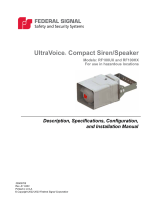 Federal Signal RF100X UltraVoice® Hazardous Area Siren/Speaker User manual
Federal Signal RF100X UltraVoice® Hazardous Area Siren/Speaker User manual
-
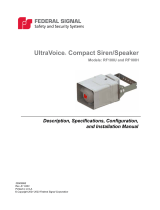 Federal Signal RF100 UltraVoice® Compact Siren/Speaker User manual
Federal Signal RF100 UltraVoice® Compact Siren/Speaker User manual
-
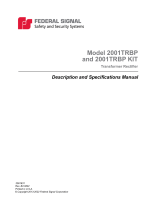 Federal Signal 2001-130 and Equinox Sirens User manual
Federal Signal 2001-130 and Equinox Sirens User manual
-
Federal Signal UltraVoice® UVLOC-B Local Operating Console User manual
-
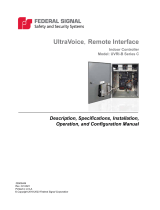 Federal Signal UltraVoice® Indoor Remote Interface Controller User manual
Federal Signal UltraVoice® Indoor Remote Interface Controller User manual
-
Federal Signal FC Siren Controller User manual
-
Federal Signal SS2000+ Series C Local Hardware Activation Point User manual
-
Federal Signal DFC Series Push Bumper User manual
-
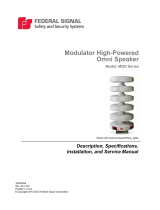 Federal Signal Modulator® Electronic Siren Series User manual
Federal Signal Modulator® Electronic Siren Series User manual
-
 Federal Signal RF100X UltraVoice® Hazardous Area Siren/Speaker User manual
Federal Signal RF100X UltraVoice® Hazardous Area Siren/Speaker User manual
Other documents
-
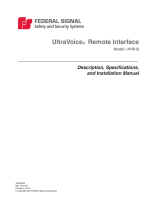 Federal Signal Corporation UVRI-B Installation guide
Federal Signal Corporation UVRI-B Installation guide
-
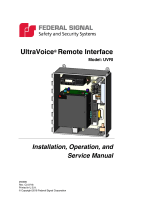 Federal Signal Corporation UltraVoice Installation, Operation And Service Manual
Federal Signal Corporation UltraVoice Installation, Operation And Service Manual
-
Cisco AIR-ANT2450S-R= User manual
-
Cisco AIR-ANT2420V-N= Datasheet
-
Cisco AIR-ANT58G10SSA-N Datasheet
-
Campbell Scientific RF500M Owner's manual
-
Cradlepoint ARC MBR1400 Series Installation guide
-
Enterasys Networks Outdoor Antenna User manual
-
Enterasys Networks Outdoor Antenna User manual
-
Campbell Scientific Modem RF400 User manual

























